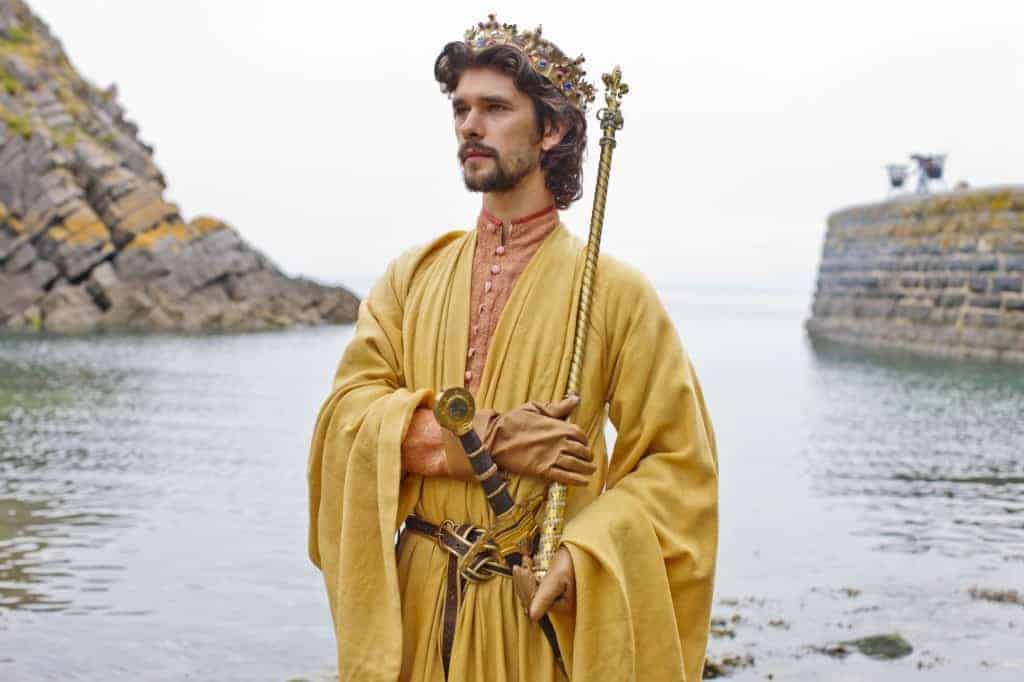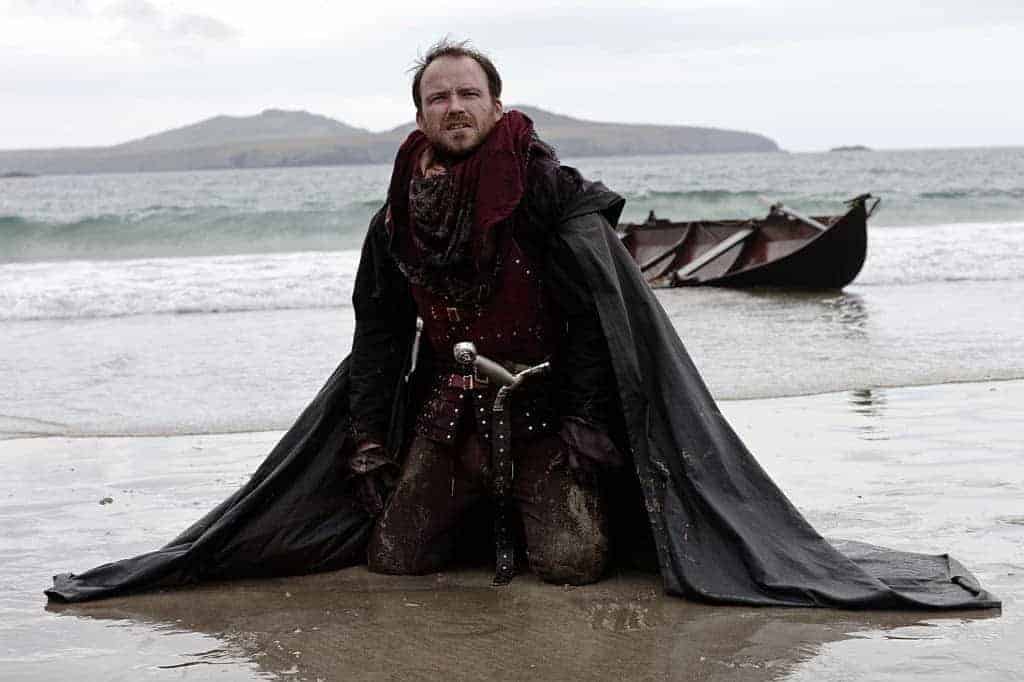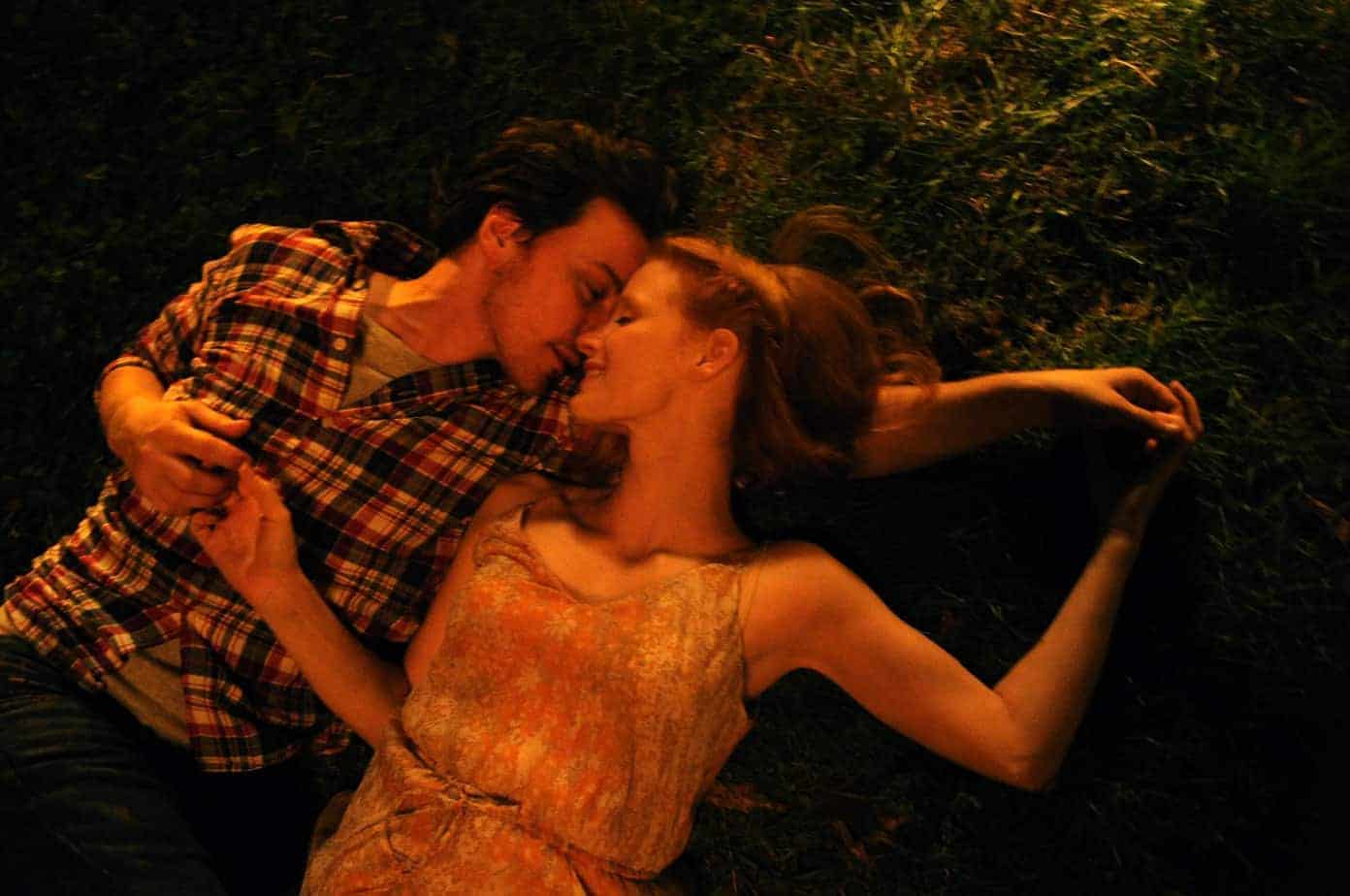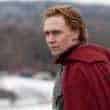Ben Whishaw gives an unparalleled performance as Richard II in the first episode of the Hollow Crown, directed by Rupert Goold.
Read our review of Rupert Goold’s Richard III on stage, and our interview with Goold on directing film vs. theatre. You can also read our reviews of the next installments: Henry IV Part 1, Henry IV Part 2, and Henry V.

Let’s talk of graves, of worms, and epitaphs;
Write sorrow on the bosom of the earth,
..let us sit upon the ground
And tell sad stories of the death of kings;
How some have been deposed; some slain in war,
Some haunted by the ghosts they have deposed;
Some poison’d by their wives: some sleeping kill’d;
All murder’d.
Rupert Goold’s screen adaptation of William Shakespeare’s Richard II opens with Richard II (Ben Whishaw) speaking this abridged monologue in voiceover, which augurs the tumultuous events to come in this four-part BBC miniseries, The Hollow Crown, about monarchs, leadership, and fathers and sons. Executive Producer Sam Mendes had the idea to make a new television adaptation of Shakespeare’s Henriad plays shot on location. The series brings together Shakespeare’s history tetralogy – “Richard II”, “Henry IV Part 1”, “Henry IV Part 2”, and “Henry V” – which chart the changes in leadership of three English Kings: the rightful heir but weak King Richard II (Ben Whishaw), his usurper Henry Bolingbroke or Henry IV (Rory Kinnear and Jeremy Irons), and the usurper’s rightful heir, Prince Harry (Tom Hiddleston), who would become Henry V.
The Hollow Crown series is phenomenal, with beautiful photography and unparalleled acting: it wouldn’t be possible to assemble such an impressive cast on stage all at once. And for plays that are so much about playing parts and keeping up appearances, close-ups are invaluable for showing us the characters’ innermost thoughts, which are not on full display to their audience at court or in public. In the first episode, there’s a great, if heavy-handed, scene where Richard stands on a rampart to speak to Bolingbroke and his supporters. He seems strong and authoritative, except when we cut to close-up and see the sweat and fear on his face.

It’s unfortunate that the cast of “Richard II” differs from that of the latter three plays in the Hollow Crown series, which makes “Richard II” seem more like an enjoyable and important but not critical prequel, like The Hobbit to The Lord of the Rings. If you missed “Richard II” last week, you can still jump into “Henry IV Part 1” tonight, but it’s worth revisiting “Richard II” later, both to clear up the backstory and get a better sense of the themes. All four plays deal with the burden of wearing the hollow crown and what it means to be a monarch and a politician; watching “Richard II”, the story of the rightful but thoughtless king, helps give perspective on the stronger leadership styles of his usurper Henry IV and the usurper’s son, Henry V.
As Richard II, Ben Whishaw is commanding, if effeminate, and working constantly to construct a complex performance, which deservedly won him the BAFTA for Best Actor on a television series. Whishaw also has an impressive ease with the language, which both emphasizes the poetry of it while seeming perfectly natural and even modern. Born into royalty, Richard II starts off the play at ease, convinced of his divine right to govern. Whishaw’s Richard has some of the camp of Michael Jackson, complete with pet monkey, but sees himself as a Christ figure, chosen by God to rule, and done an injustice when he is usurped.
When the play begins, Thomas Mowbray and Henry Bolingbroke (Kinnear) come to the King accusing each other of treason. To settle this, the King first proposes a duel, but grows scared and banishes them both just before the battle begins. It is the first of a series of rash decisions made in a desperate attempt to protect his power without seriously considering the threats to it, which will lead to his downfall.
Richard starts to lose the favour of his people when he creates outrageous taxes to support his lavish lifestyle and his wars in Ireland. Yet he is utterly oblivious, even after Bolingbroke’s dying father, John of Gaunt (Patrick Stewart, in a great turn in this supporting role), warns him, “Landlord of England art thou now, not king”. But Richard is so self-absorbed that he ignores this proclamation, and proceeds, without even a beat for contemplation, to seize all of Gaunt’s property for himself, which should have rightfully gone to the exiled Bolingbroke. We watch as the other nobles watch Richard exercise this gross abuse of power, which looks like thievery: it’s the final catalyst for Richard’s downfall.
Richard’s haughtiness is part of what makes him incapable of being a good politician. Yet he does seem to understand what Bolingbroke only later will: “uneasy lies the head that wears a crown”. Richard rightly anticipates his own fate and the future troubles that Henry IV will face in the wake of deposing the rightful king. Kinnear’s Bolingbroke is a naive, devoted son and valiant warrior who can easily earn the respect of others. But we see little of the cunning politicking that Henry IV will later brag to his son about, and the position seems more thrust on him than campaigned for.
Goold takes his time with the film, which sometimes feels slow, especially at the beginning, but does so in order to let the visuals help with the storytelling. Richard’s inflated ego and heightened sense of self is mimicked by the heightened visuals: the greens of the English countryside rich, the clothes that Richard wears sumptuous, and the prison Richard eventually finds himself in is as dark and dank as can be. Most importantly, the film will whet your appetite for the three episodes to come, with Richard prophesying the unrest that will undoubtedly follow in Bolingbroke’s reign.
More reviews of The Hollow Crown: Henry IV Part 1, Henry IV Part 2, and Henry V.

